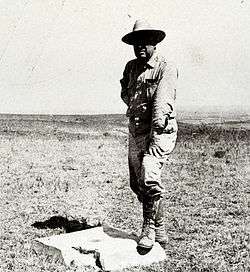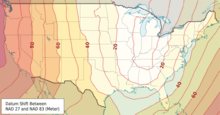North American Datum
The North American Datum (NAD) is the horizontal datum now used to define the geodetic network in North America. A datum is a formal description of the shape of the Earth along with an "anchor" point for the coordinate system. In surveying, cartography, and land-use planning, two North American Datums are in use for making lateral or "horizontal" measurements: the North American Datum of 1927 (NAD 27) and the North American Datum of 1983 (NAD 83). Both are geodetic reference systems based on slightly different assumptions and measurements.

| Geodesy | ||||||||||||||||||||||||||
|---|---|---|---|---|---|---|---|---|---|---|---|---|---|---|---|---|---|---|---|---|---|---|---|---|---|---|
 | ||||||||||||||||||||||||||
|
Fundamentals |
||||||||||||||||||||||||||
|
Concepts |
||||||||||||||||||||||||||
|
Technologies
|
||||||||||||||||||||||||||
|
Standards (history)
|
||||||||||||||||||||||||||
Vertical measurements, based on distances above or below Mean High Water (MHW), are calculated using the North American Vertical Datum of 1988 (NAVD 88).[1]
NAD 83, along with NAVD 88, is set to be replaced with a new GPS- and gravimetric geoid model-based geometric reference frame and geopotential datum in 2022.[2]
First North American Datum
In 1901 the United States Coast and Geodetic Survey adopted a national horizontal datum called the United States Standard Datum, based on the Clarke Ellipsoid of 1866. It was fitted to data previously collected for regional datums, which by that time had begun to overlap. In 1913, Canada and Mexico adopted that datum, so it was also renamed the North American Datum.[3][4]
North American Datum of 1927
As more data were gathered, discrepancies appeared, so the datum was recomputed in 1927, using the same spheroid and origin as its predecessor.
The North American Datum of 1927 (NAD 27) was based on surveys of the entire continent from a common reference point that was chosen in 1901, because it was as near the center of the contiguous United States as could be calculated: It was based on a triangulation station at the junction of the transcontinental triangulation arc of 1899 on the 39th parallel north and the triangulation arc along the 98th meridian west that was near the geographic center of the contiguous United States. [5][6][7][8] The datum declares the Meades Ranch Triangulation Station to be 39°13′26.686″ north latitude, 98°32′30.506″ west longitude.[9] NAD 27 is oriented by declaring the azimuth from Meades Ranch to Waldo[10] to be 255°28′14.52″ from north. The latitude and longitude of every other point in North America is then based on its distance and direction from Meades Ranch: If a point was X meters in azimuth Y degrees from Meades Ranch, measured on the Clarke Ellipsoid of 1866, then its latitude and longitude on that ellipsoid were defined and could be calculated.
| Ellipsoid | Semimajor axis (by definition) |
Semiminor axis (by definition) |
Inverse flattening (calculated) |
|---|---|---|---|
| Clarke 1866 | 6,378,206.4 m | 6,356,583.8 m | 294.978698214 |
These are the defining dimensions for NAD 27, but Clarke actually defined his 1866 spheroid as a = 20,926,062 British feet, b = 20,855,121 British feet. The conversion to meters uses Clarke's 1865 inch-meter ratio of 39.370432. The length of a foot or meter at the time could not practically be benchmarked to better than about 0.02 mm.[11]
Most USGS topographic maps were published in NAD 27 and many major projects by the United States Army Corps of Engineers and other agencies were defined in NAD 27, so the datum remains important, despite more refined datums being available.
North American Datum of 1983
Because Earth deviates significantly from a perfect ellipsoid, the ellipsoid that best approximates its shape varies region by region across the world. Clarke 1866, and North American Datum of 1927 with it, were surveyed to best suit North America as a whole. Likewise, historically, most regions of the world used ellipsoids measured locally to best suit the vagaries of Earth's shape in their respective locales. While ensuring the most accuracy locally, this practice makes integrating and disseminating information across regions troublesome.
As satellite geodesy and remote sensing technology reached high precision and were made available for civilian applications, it became feasible to acquire information referred to a single global ellipsoid. This is because satellites naturally deal with Earth as a monolithic body. Therefore, the GRS 80 ellipsoid was developed for best approximating the Earth as a whole, and it became the foundation for the North American Datum of 1983. Though GRS 80 and its close relative, WGS 84, are generally not the best fit for any given region, a need for the closest fit largely evaporates when a global survey is combined with computers, databases, and software able to compensate for local conditions.
| Ellipsoid | Semimajor axis (by definition) |
Semiminor axis (by definition) |
Inverse flattening (calculated) |
|---|---|---|---|
| GRS 80 | 6,378,137 m | 6,356,752.3141 m | 298.257222101 |
Comparing NAD 27 to NAD 83

A point having a given latitude and longitude in NAD 27 may be displaced on the order of many tens of meters from another point having the identical latitude and longitude in NAD 83, so it is important to specify the datum along with the coordinates. The North American Datum of 1927 is defined by the latitude and longitude of an initial point (Meades Ranch Triangulation Station in Kansas), the direction of a line between this point and a specified second point, and two dimensions that define the spheroid. The North American Datum of 1983 is based on a newer defined spheroid (GRS 80); it is an Earth-centered (or "geocentric") datum having no initial point or initial direction.
NOAA provides a converter between the two systems.[12] The practical impact is that if you use a modern GPS device set to work in NAD 83 or WGS 84 to navigate to NAD 27 coordinates (as from a topo map) near Seattle, you would be off by about 95 meters (not far enough west), and you'd be about 47 meters off near Miami (not far enough north-northeast), whereas you would be much closer for points near Chicago.
North American Datum 1983 and World Geodetic System 1984
The definition of NAD 83(1986) is based on the GRS 80 spheroid, as was WGS 84, so many older publications indicate no difference. WGS 84 subsequently changed to a slightly less flattened spheroid. Subsequent measurements therefore produce a difference on the order of a meter over much of the United States. Each datum has undergone refinements with more accurate and later measurements.
In addition, NAD 83 is defined to remain constant over time for points on the North American Plate, whereas WGS 84 is defined with respect to the average of stations all over the world. Thus the two systems naturally diverge over time. For much of the United States the relative rate is on the order of 1 to 2 cm per year. Hawaii and the coastal portions of central and southern California west of the San Andreas Fault are not on the North American plate, so their divergence rate differs.
Current version of North American Datum
The United States National Spatial Reference System NAD 83(2011/MA11/PA11) epoch 2010.00, is a refinement of the NAD 83 datum using data from a network of very accurate GPS receivers at Continuously Operating Reference Stations (CORS).
New Datum of 2022
To improve the National Spatial Reference System NAD 83, along with North American Vertical Datum of 1988 (NAVD 88), is set to be replaced with a new GNSS- and gravimetric geoid model-based geometric reference frame and geopotential datum in 2022.[2]
The new reference frames will rely primarily on Global Navigation Satellite Systems (GNSS), such as the Global Positioning System (GPS), as well as on a gravimetric geoid model resulting from our Gravity for the Redefinition of the American Vertical Datum (GRAV-D) Project.
These new reference frames are intended to be easier to access and to maintain than NAD 83 and NAVD 88, which rely on physical survey marks that deteriorate over time.[2]
References
- North American Vertical Datum of 1988 (NAVD 88), at National Geodetic Survey
- New Datums: Replacing NAVD 88 and NAD 83
- Shalowitz, USC&GS Field Engineers Bulletin, December 1938
- Craig, Cindy (October 2013) "Where Theory Meets Practice: United States Standard Datum" Professional Surveyor Magazine Frederick, Maryland
- US Coast & Geodetic Survey, "Triangulation in Kansas", Special Publication No. 70 (1921)
- Bulletin of the National Research Council, Issues 77-80, p. 230
- Van Zandt, Boundaries of the United States and the several states, p. 265
- Walter H. Schoewe, "Kansas and the geodetic datum of North America", Transactions of the Kansas Academy of Science 51 (1948) 117–124, www.jstor.org
- NGS data
- Waldo
- Cardarelli, Francois Encydopaedia of scientific units, weights, and measures: their SI equivalences and origins, Springer-Verlag London Limited 2003, ISBN 1-85233-682-X, p. 5, table 2.1, data from Giacomo, P., Du platine a la lumiere, Bull. Bur. Nat. Metrologie, 102 (1995) 5–14.
- NOAA's NAD 27 vs. NAD 83 converter
External links
- NOAA-NGS-coordinates CORS-active network - explanation of NAD 83(2011/MA11/PA11) epoch 2010.00
- NOAA-NGS-coordinates passive network - explanation of most recent adjustment of passive network
- NADCON – a free utility for Microsoft Windows to convert between NAD 27 and NAD 83
- nadcon.prl – a web-based utility for NADCON
- NAD 83: What Is It and Why You Should Care by Dane E. Ericksen, P.E., Hammett & Edison, Inc., Consulting Engineers. 1994 SBE National Convention and World Media Expo.